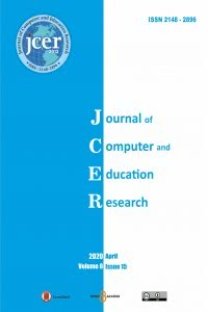Ders İzlencesi Oluşturulmasında Öğrencilerin Aktif Olarak Dâhil Edilmesi: Örnek Bir Çalışma
İhtiyaç analizi, ortaokul öğrencileri, seçmeli ders, dil öğretimi, izlence
Involving Learners as Active Participants in Designing a Course Syllabus: A Sample Research
Needs analysis, learners, elective course, language teaching, syllabus,
___
- Akyel, A. S. & Ozek, Y. (2010). A language needs analysis research at an English medium university in Turkey. Procedia Social and Behavioral Sciences, 2 , 969–975. doi:1016/j.sbspro.2010.03.136
- Chia, H-U., Johnson, R., Chia, H-L. & Olive, F. (1999). English for college students in Taiwan: A study of perceptions of English needs in a medical context. English for Specific Purposes, 18 (2), pp. 107–119. Retrieved December 26, 2012 from http://dx.doi.org/10.1016/S0889-4906(97)00052-5
- Chostelidou, D. (2011). Needs-based course design: the impact of general English knowledge on the effectiveness of an ESP teaching intervention. Procedia Social and Behavioral Sciences 15 , 403–409.
- Cowling, J. D. (2007). Needs analysis: Planning a syllabus for a series of intensive workplace courses at a leading Japanese company. English for Specific Purposes, 26 , 426–442. doi: 1016/j.esp.2006.10.003
- Dehnad, A., Bagherzadeh, R., Shoaleh, B., Hatami, K. & Hosseini, F. (2010). Syllabus revision: A needs analysis study. Procedia Social and Behavioral Sciences, 9 , 1307–1312. doi: 1016/j.sbspro.2010.12.325
- Harmer, J. (2007). The Practice of English Language Teaching (4 th ed.) . England: Ashford Colour Press Ltd.
- Holliday, A. (1995). Assessing language needs within an institutional context: An ethnographic approach. English for Specific Purposes, 14 (2), pp. 115–126. Retrieved December 2, 2012 from http://www.sciencedirect.com/science/article/pii/088949069500006D
- İnceçay, G. & İnceçay, V. (2010). A case study on needs assessment of English language teachers. Procedia Social and Behavioral Sciences, 2 , 317–321. doi:1016/j.sbspro.2010.03.017
- Kusumoto, Y. (2008). Needs analysis: Developing a teacher training program for elementary school homeroom teachers in Japan. Second Language Studies , 26 (2), 1–44. Retrieved December 2, 2012 from http://hawaii.edu/sls/uhwpesl/26(2)/Kusumoto.pdf Lehtonen, T. & Karjalainen, S. (2008). University graduates’ workplace language needs as perceived by employers. System, 36 , 492–503. doi:10.1016/j.system.2008.01.003 Long, M. H. (Ed.). (2005). Second Language Needs Analysis . United Kingdom: Cambridge University Press.
- MoNE, 20 Fourth and fifth grade English course yearly plan. http://www.ingilizcecin.com/doc/2873/2012-2013-8-sinif-ingilizce-yillik-planiindir.html
- Moon, J. (2000). Children in Learning English. Oxford: Macmillan Heinemann.
- Phillips, S. (2001). Young Learner’s Tool Kit. Turkey, British Council.
- Richards, J. C. (2001). Curriculum Development in Language Teaching . New York, United States: Cambridge University Press.
- Richards, J. C. (2013). Curriculum approaches in language teaching: Forward, central, and backward design. RELC Journal, 44 (1), 5–33. doi: 10.1177/0033688212473293 Wozniak, S. (2010). Language needs analysis from a perspective of international professional mobility: The case of French mountain guides. English for Specific Purposes 29 , 243– 2 doi:10.1016/j.esp.2010.06.00
- Yayın Aralığı: 2
- Başlangıç: 2013
- Yayıncı: Tamer KUTLUCA
Medya İletilerinin Gerçeği Yansıtma Düzeylerinin Öğrenci Görüşlerine Göre Tespiti
Fatih GÜNER, Naci TOPALOĞLU, Salih Zeki GENÇ
Diyarbakır’da Öğretmen Yetiştirme Deneyimleri
Şefika İZGİ TOPALAK, Tarkan YAZICI
Ders İzlencesi Oluşturulmasında Öğrencilerin Aktif Olarak Dâhil Edilmesi: Örnek Bir Çalışma
Zeki APAYDIN, Emrah AKMAN, Erol TAŞ, Evşen Aymen PEKER
Cronbach’ın Alfası, Tek Boyutluluğun veya Benzeşikliğin (Homojenliğin) Bir Ölçüsü Değildir
İlköğretim Matematik Öğretmen Adaylarının Öğretmenlik Mesleğine Yönelik Tutumlarının İncelenmesi
Web Destekli Öğrenme Halkası Yaklaşımı Uygulamalarına İlişkin Öğrenci Görüşleri
